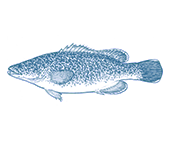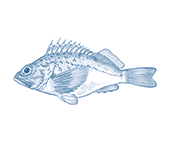




- Better Choice
Wild Caught
Region:
VIC
- Silver trevally are mostly caught in Victorian waters using haul seine nets. The method poses low risk to sea grass habitats.
- Victorian silver trevally stocks appear healthy but careful monitoring will be required in future.
- The Corner Inlet Fishery, which takes the biggest catch of silver trevally in Victoria, has implemented restrictions on fishing effort. Net fishing in Port Philip Bay was phased out in 2018, further reducing effort in the region. No-take marine park areas also likely provides protection and resilience to the stock.
- While some the trawled area in the Commonwealth fishery has been mapped, and sensitive habitat has been identified that is affected by trawling, there is limited information available on the type of habitat affected by trawl fisheries operating in NSW and NZ.
- The fishery has been operating with a code of practice since 2020 to limit fishing effort to assist with the sustainability of stocks, and minimise bycatch (the accidental catch of non target species) and habitat damage.
- Corner Inlet fishery, Ocean Fishery (29t in 2019/20, 24t in 2018/19)
The Silver Trevally species complex (several species are described as silver trevally in Australian fisheries, and species-level distinction is not made in any fishery) is a predatory fish found over a broad range of habitats, from shallow estuaries through to the outer continental shelf. Silver trevally is a relatively long lived (up to 40 years) and slow growing species, which makes it vulnerable to fishing pressure.
Commercial catches exist in all sub-tropical and temperate Australian jurisdictions, with only small catches taken other than in Victoria. Silver trevally are mostly caught in Victorian waters using haul seine nets in the Corner Inlet Fishery.
The size of silver trevally catches have been generally stable but the slightly lower catch rate in the most recent fishery assessment is of slight concern given evidence of rapid declines of silver trevally in other jurisdictions. Careful monitoring will be required.
Measures instigated by the Corner Inlet Fishery to limit bycatch include fishing at night (which reduces seabird bycatch), devices in their nets which help bycatch escape and the use of in water sorting of catch in their nets leading to the release of bycatch. Nets are also attended and soak times are short. These practices help ensure a high survival rate of species that have not been targeted.
In the Corner Inlet, silver trevally are targeted alongside King George whiting, rock flathead, Australian salmon, yellow eye mullet and southern calamari.
The haul seine method generally has low impacts on marine habitat and threatened species, although increased reporting by independent fisheries observers would provide additional confidence in reporting of endangered species interactions.
The fishery operates within a RAMSAR listed wetland, making it habitat for a range of protected bird species. ‘No-take’ zones within a marine park in the region provide additional protection for marine species.


